Crowded Mexico City and colonization of space
This week Diane and I are in Mexico with friends doing some sightseeing. As is my habit, I can’t just enjoy the sights I have to ask a lot of questions while trying to get an impression of the place, its culture, its environment, its atmosphere, and its politics. Not surprisingly, the answers to some of those questions pointed me upward beyond the surface of the Earth. To understand why, read on.
Today we toured the inner parts of Mexico City, both on foot and by bus and subway (or the Metro as they call it here). I have spent considerable time in many of the world’s major cities, growing up in New York and visiting at length Moscow, Kiev, Prague, London, Chicago, Los Angeles and others. Mexico City has many of the same features you’d expect for this kind of big city, lots of people, lots of traffic, lots of buildings packed tight together, and lots of wealth and poverty sitting side-by-side.
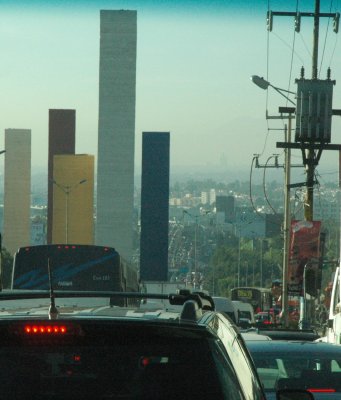
Mexico City however to me seemed to be most crowded and the most packed of any city I have ever visited or lived in. Its size and population probably rivals that of the entire New York metropolitan area, but somehow the traffic and crowds and architecture seemed more piled on top of each other with far less breathing room.
First was the traffic. Everywhere we went it was wall to wall vehicles. The major highways were never quiet, even at night. Nor could I see much difference between midday and rush hours. The picture on the right shows us heading from in from an outer neighborhood where we were staying to take the subway into the center of the city. Not only was it bumper-to-bumper, but if you look out in the distance the road is bumper-to-bumper as far as the eye can see. My host Alfonso added at one point that in order to avoid this traffic many people routinely leave for work before 5 am and come home after 8 pm. Schools have multiple shifts, including ones at night.
A side note: The tall rectangular structures in the foreground are not buildings. This is a work of art, five several hundred foot tall cinderblock structures supposedly forming a hand pointing up, with the thicker yellow tower in the front representing the thumb.
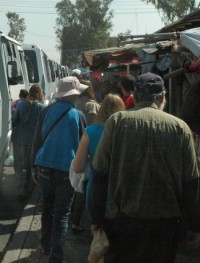
At the subway there was no let up. The sidewalks were packed with people and vendors, as shown on the left. So were the tunnels leading to the subway itself. Every wall and sidewalk was lined with small street shops each about ten feet across, selling anything from fruits to candy to books to trinkets to whatever you can imagine. In the subway itself vendors walked through the train continually, hawking anything from pens to chewing gum to music CDs.
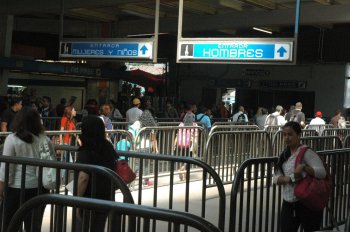
Even the line to enter the station’s turnstiles was like a long snaking bank line, except that there were two lines, the longer line for men and the shorter for women and children, as can be seen by the signs in the image to the right.
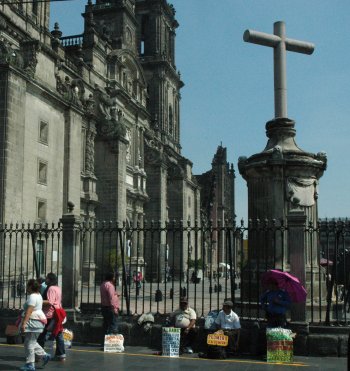
We visited two main sites in our tour of the inner city. First was the Metropolitan Cathedral, pictured on the far right, at the town’s central municipal square. The men lined up in front of the fence are a variety of home repairmen, plumbers and carpenters, advertising their services to the general public. If you need a plumber, this is one way you can find one.
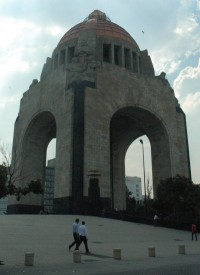
Next we went to what they call Revolution Monument, shown on the immediate right. This building, which commemorates Mexico’s independence and is the burial site for many of their most important historical figures, was almost a century in the making, with its construction beginning in late 1880s and paused either because of lack of cash or because another revolution had occurred and the new leaders were uninterested in finishing it. In fact, the tour we took inside its structure was only finished in the last year or so, with the whole building only recently undergoing a complete reconstruction to create the Monument you see in these pictures.
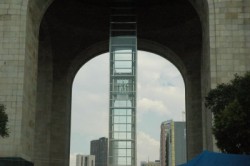
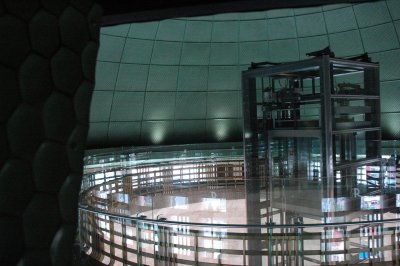
The tour first took us down into the bowels of the structure to show the complex steel foundation. Then we took an elevator up into the top of the monument (shown above) and then stairs into its inner structure. I took the picture to the right from inside that structure, looking out at the top of the elevator tower in the center of the monument’s inner dome of copper. The outer dome, visible from the street, is a metal framework that holds up the inner dome and is covered with a stone facade.
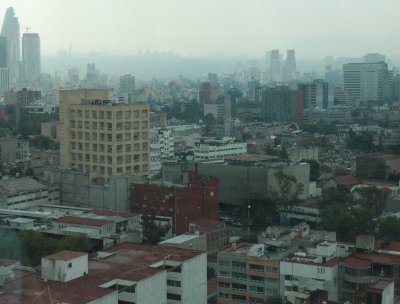
At the very top of the Monument we could look out at all of Mexico City. In every direction were buildings upon buildings, packed together and fading into the distant haze of the city’s ever-present smog.
While I have great faith in the ability of humans to adapt to any condition, and could see a clear demonstration of this in the manner in which Mexico City’s citizens were doing exactly that, I was still struck with a sense that maybe the city’s capacity to function was getting close to its limits. I suspect that I am wrong, but nonetheless, I did get that feeling. It will be a great challenge for future generations to deal with these issues and find a solution to them.
One solution I can suggest, which should not surprise anyone who reads anything I write, would be to learn how to get off this Earth and live on other worlds. Eventually, that would give us all breathing room and make it possible to send back to Earth the almost unlimited energy and resources that can be found in space to make living on Earth easier and more worthwhile, no matter how crowded it becomes.
I think future generations will embrace this solution. In fact, I think the present generation is doing so now. Whether we can make it happen fast enough to make a positive difference is probably the biggest challenge of all.
On Christmas Eve 1968 three Americans became the first humans to visit another world. What they did to celebrate was unexpected and profound, and will be remembered throughout all human history. Genesis: the Story of Apollo 8, Robert Zimmerman's classic history of humanity's first journey to another world, tells that story, and it is now available as both an ebook and an audiobook, both with a foreword by Valerie Anders and a new introduction by Robert Zimmerman.
The print edition can be purchased at Amazon or from any other book seller. If you want an autographed copy the price is $60 for the hardback and $45 for the paperback, plus $8 shipping for each. Go here for purchasing details. The ebook is available everywhere for $5.99 (before discount) at amazon, or direct from my ebook publisher, ebookit. If you buy it from ebookit you don't support the big tech companies and the author gets a bigger cut much sooner.
The audiobook is also available at all these vendors, and is also free with a 30-day trial membership to Audible.
"Not simply about one mission, [Genesis] is also the history of America's quest for the moon... Zimmerman has done a masterful job of tying disparate events together into a solid account of one of America's greatest human triumphs."--San Antonio Express-News


I am uncomfortable in groups of more than six people, so Mexico city is off my soon to visit list. I remember that the city itself is built upon an ancient lake bed and there is high potential for significant earth quakes. Combine that with an 8.5 million people population with another 12 or so million surrounding it, the city’s proximity to Pacific plate movement and you have a formula for serious consequence.
https://en.wikipedia.org/wiki/Lake_Texcoco
” the city has proven vulnerable to soil liquefaction during earthquakes, most notably in the 1985 earthquake when hundreds of buildings collapsed and thousands of lives were lost.”
I have a comment about this article. The Monumento a la Revolucion construction did not start in 1880. The monument to the revolution began to be built around 1906 and it was supposed to become a legislative palace. This was a building that Porfirio Diaz wanted to have in order to show how great Mexico could have been. It was never supposed to be a monument to the independence as you make it sound “This building, which commemorates Mexico’s independence…”. 1912 through 1932 construction stopped due to using the money to fight the revolution that had erupted. And in 1933 through 1938 it became the monument of the revolution we know today. Then the public access to the top and elevators was closed around 1970. It finally reopened after the renovation in 2010.
Also, the Monumento a la Revolucion does not commemorate Mexico’s independence. It only commemorates the Mexican Revolution which was a movement to take down Porfirio Diaz who had been in power for more than 30 years and was considered a Dictator. Also, the people buried at the bottom are only people involved with the revolution.
Thank you for the corrections, here and on my other Mexico City post. I wrote these posts while in Mexico City on a trip, and because of limited internet availability, depended on things like Wikipedia to get my facts, something I try to avoid whenever possible. This experience demonstrates why I try to avoid Wikipedia whenever possible.
Until I read your comment here, I had not realized the distinction between Mexico’s independence and its revolution. Nor had I been aware of the dictatorship of Porfirio Diaz. Knowing these facts now helps clarify much of what I have heard about Mexico’s history. Thank you again.